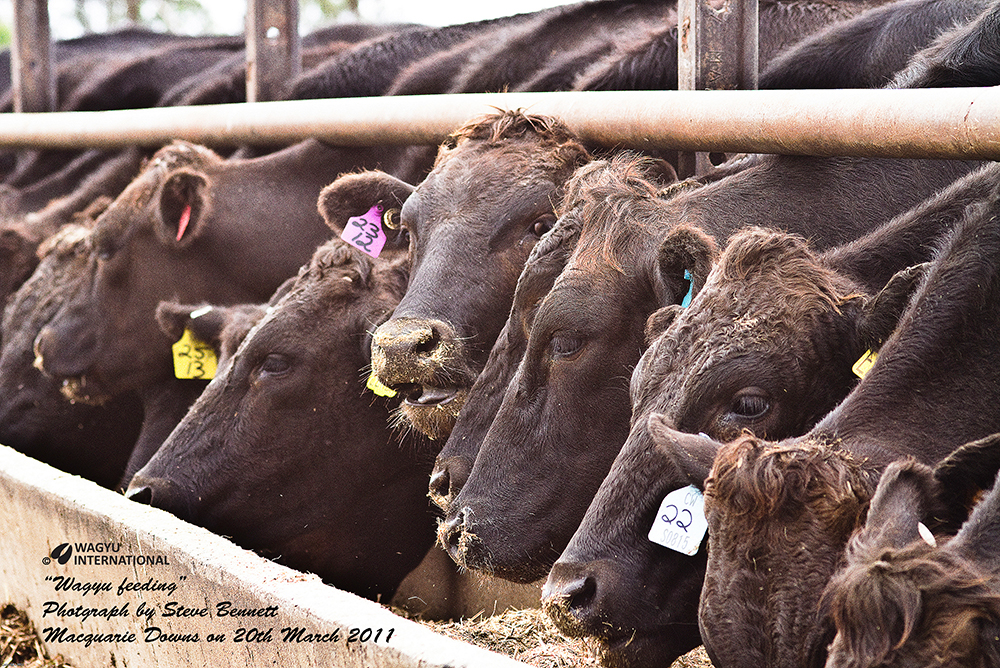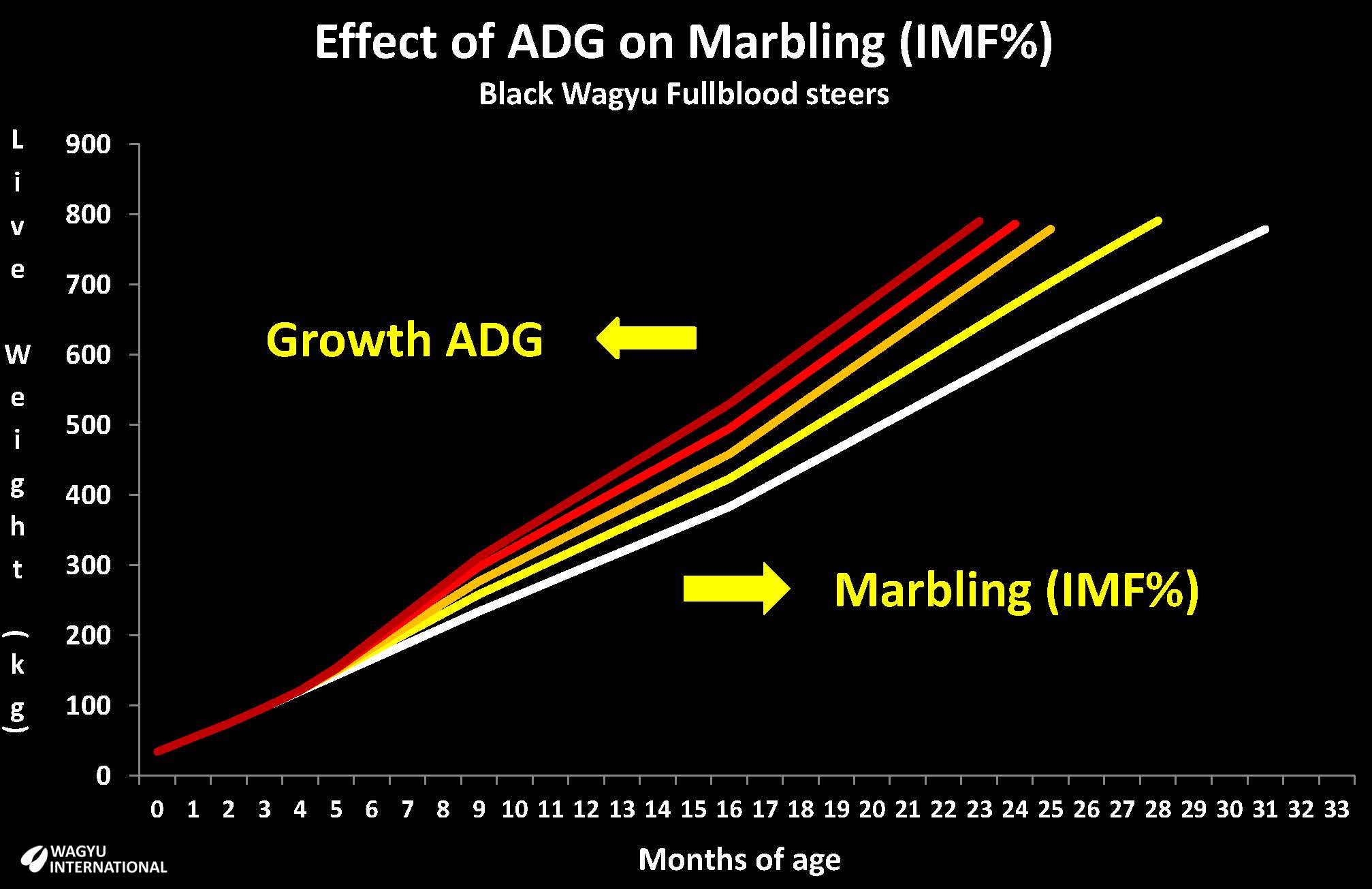Wagyu nutrition

Origins of the Wagyu breed
Wagyu breeds have unique qualities that are attributed to origins from the First Aurochs of the Near East. The early arrivals of domesticated cattle to Asia trace back to ancient European aurochs and migration of Northeast taurine cattle to the Korean peninsula 2,000 BCE. The origins of most Japanese breeds are towards the end of the 2nd Century from Korea whilst a later strand went directly to North Japan after 1454 AD. Isolation for almost two thousand years has enabled Wagyu to have retained key differences from other breeds while they are classified to be on the extreme within the Bos taurus pool.
Establishment of Wagyu International principles for Wagyu nutrition
Initially research data over 20 years from Japan was analysed and some preliminary principles were adopted by Wagyu International. Subsequently the translation of the Japanese Beef Feed Standard 2008 provided additional information.
The Japanese cattle industry requires a large component of feed that is imported and ongoing increases in production costs for beef have increased subsidies by prefecture for fattening (牛マルキン). In March 2015 the policy of Modernizing Dairy and Beef Cattle Production was announced by the Ministry of Agriculture, Forestry and Fisheries. Changes are necessary to strengthen competitiveness of beef cattle production by shortening the fattening period. LIAJ estimated that shortening the fattening period by each 1 month will reduce expenses by about 5%. However, it has been acknowledged that shortening the fattening period will have an impact on carcass weight and meat quality.
Calves in Japan are typically sold to the fattening industry between 8 and 10 months of age depending on strain/prefecture. Although there are differences of sex and strain of Black Wagyu, the weight for age at the calf markets is a useful indication of finishing potential. The traits related to yield tend to increase when there is a higher weight for age. The average is 1.0 kg per day of age from Hokkaido (Osawa et al., 2008). Individuals who exceeded this had invariably been overfed and meat quality was disadvantaged.
Global constraints
In order to minimise the impact on quality by the mandate to reduce age as implemented in 2015, research on feeding has taken on a different perspective. The numerous results have been reviewed by Wagyu International and any findings that have implications for either pasture or grain finishing of Wagyu in the global arena is applied. The effect of ADG and the time to reach the same end-point on marbling (IMF%) is illustrated below:

An increase in growth rate towards the left of the chart allows slaughter weight to be achieved at a younger age but this reduces IMF% in the lines that are darker in colour. The lighter coloured lines have higher marbling from lower growth rates.
The white line shows the conventional 2008 feed standard applied to Australian conditions. Of course, marbling to this extent is not rewarded by the prevailing price grid outside Japan except for isolated niche markets. Shifting to the left reduces cost but the economics in every enterprise will dictate which coloured line will bring in the highest return.
The Wagyu breed thrives on roughage and Japan was traditionally processed at an age that exceeded 30 months. The balance of forages and grain that provided optimum performance and beef quality culminated in propionic acid fermentation during finishing. On the other hand, the dairy industry relies on butterfat production and this is favoured by acetic acid fermentation.
The acetate:propionate ratio is important but there is a negative trend between NDF and IMF%. Research data from fattening trials in Japan have been reviewed by Wagyu International is continually monitoring progress in Japan and applying it through collaborations with producers in the northern and southern hemispheres. As always, the economics and end-points are different in every enterprise. Determination of the desired eating quality and carcass size will enable Wagyu International to recommend the growth profile and feeding program that will be based on local resources and feed components.
Producers in Japan are required to process at an earlier age to reduce feed imports and to increase self-sufficiency. There are incentives to raise beef on hilly terrain. The BMS nd IMF% content will progressively decrease.
Producers in EU are being challenged to reduce livestock numbers because of environmental concerns and there are ripple effects over the globe.
Conventional husbandry practices are being forced to change within narrow timelines.
Collaborations
Since Wagyu International has been evaluating research and husbandry in Japan, collaborations have been undertaken in the southern and northern hemisphere with Wagyu producers finishing with grass or grass or both. The carcass data from the same genetics has been evaluated from grain from 24 months of age in Australia and compared at up to 43 months from pasture in Europe. The objectives and challenges are different in every operation. Wagyu International can evaluate the best options for both genetic and nutritional inputs because they are intimately related.
The Wagyu breed is unique because of its inherent qualities. Some tweaking will be required to continue to deliver that excellence during a shift in practices.
References
Luebbe 2014. Methane's Impact on Animal Performance - VFAs. University of Nebraska - Lincoln. March 2014.
Ogata et al., 2019. Effects of an increased concentrate diet on rumen pH and the bacterial community in Japanese Black beef cattle at different fattening stages. J. Vet. Med. Sci. 81(7): 968–974
Ogata et al., 2019. Long-term high-grain diet altered the ruminal pH, fermentation, and composition and functions of the rumen bacterial community, leading to enhanced lactic acid production in Japanese Black beef cattle during fattening. PLoS ONE 14(11): e0225448
Osawa et al., 2008. Image analysis of carcass cross-section in Japanese Black Genetic analysis of traits and meat-producing ability traits. Report posted in Japanese by Department of Bioproduction Science, Graduate School of Agricultural Sciences, Iwate University.
